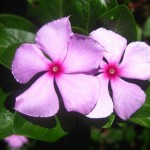Active Principal:
Chemical constituents present in crude animal or vegetable preparations responsible for biological activity are called active principles.
Important active principles include:
- Alkaloids
- Glycosides
- Saponins
- Fixed and volatile oils
- Fats
- Waxes
- Gums
- Resins
- Oleoresins
- Gum resins
- Balsams
- Tannins
- Neutral principles
Photo of Catharanthus roseus, source of alkaloids by tonrulkens
1. Alkaloids:
Alkaloids are the nitrogenous compounds having complex structure.
Source:
They are obtained from plants.
Taste:
They are bitter in taste.
Biological activity:
Alkaloids are biologically very active compounds.
Nature:
Alkaloids are basic in nature.
Reaction with acids:
With acids, alkaloids form salts.
Solubility:
Alkaloids are not soluble in water but are soluble in alcohol. Their salts are water soluble.
Physical State:
Alkaloids are mostly solids and rarely liquids.
Name:
English name ends in “ine”.
Examples:
Examples include :
a. Solids :
Atropine, hyosine, quinine, strychnine, codeine and theobaine.
b. Liquids :
Nicotine, lobeline and pilocarpine.
2. Glycosides :
Glycosides are non-nitrogenous compounds having complex structure similar to the alkaloids.
Source:
Glycosides are obtained from plants
Biological activity:
Glycosides are biologically very active.
Portions:
Glycosides are hydrolyzed by enzymes and acids into two portions:
- Sugar portion- Glycone ( has pharmacokinetic properties)
- Non sugar portion- Aglycone (has pharmacodynamic properties).
If sugar portion is glucose, glycosides are known as glucosides.
Name:
English name ends in “in”.
Examples:
Examples include cardiac glycosides such as digitoxin and digoxin, gitoxin and gitalin.
3. Fixed/ Volatile Oils:
a. Fixed Oils:
Fixed oils are the esters of higher fatty acids.
Source:
Fixed oils are obtained from plant as well as animal sources.
Solubility:
They are not soluble in water but are soluble in alcohol, chloroform and ether.
Fixed oils are bland and non-irritating.
They leave a greasy mark on paper.
Distillation:
Fixed oils decompose on distillation.
Chemical Reactions:
With alkalies, they form soaps.
Pharmacological Actions:
They serve as nutrients and emollients (soften the skin).
b. Volatile Oils:
Volatile oils contain liquid hydrocarbons. Chemically they are phenols, alcohols or ketones.
Solubility:
They are slightly soluble in water.
They impart smell and taste to water.
They are highly aromatic compounds.
Pharmacological Actions:
- They have many pharmacological actions like:
- Carminatives- Cardamom oil
- Diuretics- Sandalwood oil
- Expectorants- Balsam of tolu
- Counter irritants- turpentine oil
- Antiseptics- clove oil
Physical State:
They are usually solids like camphor, thymol and menthol, but may be liquids as well, like oil of Eucalyptus (Eucalyptol).
Differences Between Volatile and Fixed Acids
| Fixed Oil | Volatile Oil |
| Source: Plant and animal | Plants only |
| Volatility: Non volatile | Volatile |
| Distillation: Decompose | Can be distilled |
| Nature: Greasy and thick in consistency | Thin and non greasy |
| Solubility in water: Completely soluble | Slightly soluble |
| Action: Non irritant, soothing when applied to skin and mucosa | Mild irritant to skin and mucosa |
| Activeness: Not much active | Quite active |
| Rancidity: Get rancid with time | Do not get rancid |
| Nutritional value: Have nutritional value | No nutritive value |
| Examples: castor oil, cod liver oil, olive oil | ANISE, camphor, eugenol, methanol |
4. Fats:
Fats are the fixed oils. These include the triglycerides.
Physical State:
They are solids at room temperature.
Sources:
Fats are obtained from plants as well as animal source.
Examples:
Examples include theobroma, lard and wool fat.
5. Saponins:
Saponins resemble glycosides and are the emulsifying agents.
Sources:
These are obtained from the plants.
Reaction:
Saponins are neutral in reaction.
Toxicity:
Saponins are toxic and cause hemolysis of RBC’s.
With water:
With water, saponins form a clear solution which makes soap like foam on shaking.
Examples:
Examples include Senegin and Quillaia Sapotoxin.
6. Waxes:
Waxes are the esters of fatty acids with monohydric alcohol. They are the complex mixtures and are used in the formation of ointments, topical preparations.
Examples include bees wax (Cera alba).
7. Gums:
Gums are the exudates of plants. They are carbohydrates, amorphous and transparent compounds which form viscous solution with water. This viscous solution is known as mucilage.
Examples include gum acacia and gum tragacanth.
8. Resins:
Resins are the solid and brittle oxidized volatile oils which form soaps with alkalies. They are soluble in alcohol.
Examples include colophonium and podophyllum.
9. Oleoresins:
Oleoresins are the resins dissolved in volatile oils. E.g. Copaiba.
10. Gum Resins:
Gum resins are the combination of gums and resins and are the exudates of plants. Examples include Myrrh and Asafetida.
11. Balsams:
Balsams are the resins in combination with benzoic acid with or without cinnamic acid. Examples include Benzoin, Peru and Tolu.
12. Tannins:
Tannins are the non nitrogenous compounds which are precipitated by metallic salts and alkalies. They are mucosa and leave a blue inky color with iron. They are hydrolyzed to tannic acid. They act as astringents which harden the mucous membrane by coagulation of proteins.
13. Neutral Principles:
Neutral principles do not confer to any special group and include Santonin and Aloin.
 howMed Know Yourself
howMed Know Yourself





